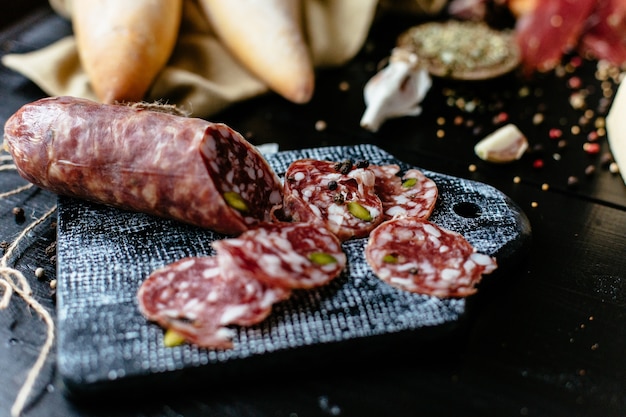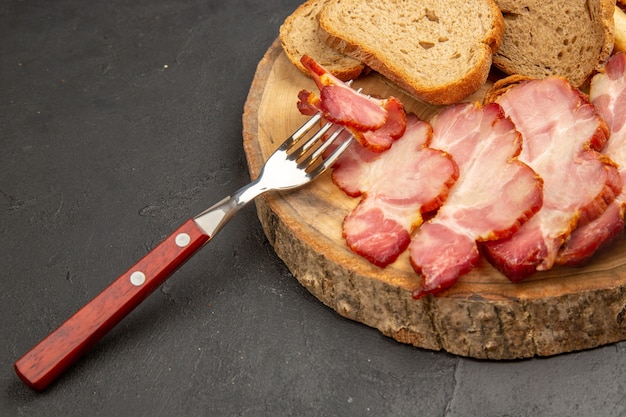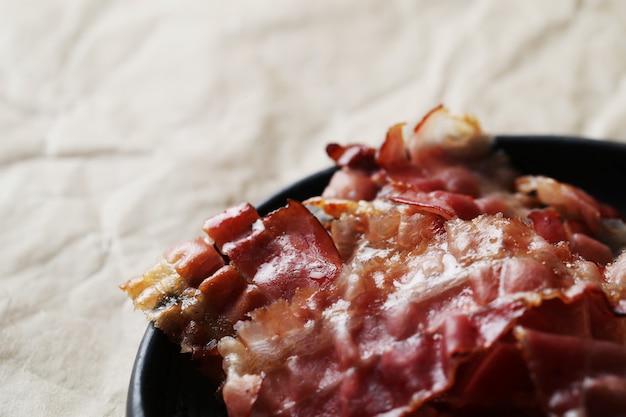Bacon. Just the word conjures up images of sizzling strips, a delightful aroma filling the kitchen, and the promise of a delicious breakfast. But let's be honest, we've all been there - faced with a bacon dilemma. Those moments when the bacon ends up dry and brittle, or worse, still a bit raw. It's a culinary conundrum that's plagued us all.
But fear not, dear reader! Through countless trials and tribulations, I've learned a thing or two about achieving bacon perfection. I've experimented with various techniques, from the classic pan-frying to the modern air fryer, and I'm ready to share my wisdom with you. Let's embark on this bacon journey together and unlock the secrets to crispy, succulent, and absolutely irresistible bacon.
(Part 1) The Great Bacon Divide: A Tale of Two Textures

Let's face it, there's a bit of a divide in the bacon world. Some folks crave those crispy, crackling edges that crumble with every bite. Others, like myself, prefer the tender, juicy center that offers a satisfying chew. Achieving that perfect balance between crispy and chewy is like finding the holy grail of breakfast!
My Bacon Odyssey: From Burnt to Bliss
My own bacon journey is a tale of both triumph and tribulation. I've experienced the highs of succulent, perfectly cooked bacon, and the lows of burnt, dry, and disappointing results. I vividly remember those early days of bacon-related disasters. You'd walk into the kitchen, the aroma of bacon filling the air, your stomach rumbling with anticipation. Then, disaster strikes - the bacon ends up a crispy, charcoal-like mess. Or, you take it off the pan too early, and it's limp and greasy. Not a pretty sight, to say the least.
The Quest for the Perfect Bacon: From Cookbook to Chef
This is where my obsession with mastering the art of bacon cooking began. I devoured countless cookbooks, watched endless Youtube tutorials, and even consulted with veteran chefs. I tried everything: different pans, varying temperatures, even the infamous "bacon weave" technique (which, by the way, is a whole other adventure!). It was a journey of experimentation, frustration, and ultimately, delicious success.
(Part 2) Deconstructing the Bacon Slice: Understanding Your Canvas

Before we dive into the techniques, let's understand what we're dealing with. A bacon slice is more than just a piece of meat; it's a culinary canvas waiting for us to paint on it!
The Thickness: A Key to Crispiness
First, consider the thickness. Thin-cut bacon is a quick-cook option, perfect for achieving that satisfying crispy finish. Think breakfast sandwiches or salads - it adds a delightful textural crunch. Thicker cuts, on the other hand, require a bit more time and effort, but the payoff is worth it. The longer cooking time allows for a more robust, chewy texture, ideal for those who crave a satisfying chew. Think of it like a slow-cooked roast - the longer the cook time, the more intense the flavor and tenderness.
Fat Content: The Flavor Factor
Next, we have the fat content. A higher fat percentage translates to a more flavorful, juicy bacon. The fat renders slowly, creating those gorgeous crispy edges while ensuring a juicy and delicious center. Lower fat bacon, while still delicious, tends to cook faster and might be slightly leaner, but be careful not to overcook it or it'll dry out.
The Cut: Your Choice of Flavor
Finally, let's talk about the cut. smoked bacon is the classic choice, offering a deep, smoky aroma that awakens your senses. unsmoked bacon is more neutral in flavor, making it a versatile option for various dishes. There are also variations like streaky bacon (usually thinner and with more fat) and back bacon (thicker and leaner), each offering a unique flavor profile.
(Part 3) Mastering the Pan: Unveiling the Secrets of Frying

Now, let's get our hands dirty! Frying is my go-to method for bacon, and it's surprisingly simple once you get the hang of it.
The Equipment: Choosing Your Weapon
First things first, you need the right pan. A cast-iron pan is my personal favorite. Its ability to retain heat beautifully ensures even cooking, resulting in perfectly crisp bacon. However, any heavy-bottomed pan will do the trick. Avoid thin pans, as they can warp and create uneven cooking.
The Technique: A Gentle Approach
Now, for the technique. The trick is to cook the bacon over medium-low heat. This way, the fat renders slowly, giving the bacon time to cook evenly and become crispy. No need to rush things; patience is key! Allow the bacon to cook undisturbed, letting the fat render slowly, and you'll be rewarded with crispy perfection.
The Flip: A Critical Step
When one side of the bacon turns a lovely golden brown, it's time to flip. Don't be afraid to give it a good flip - you want to ensure both sides achieve that crispy goodness.
The Finish: Achieving Crispy Perfection
Once the bacon has cooked to your desired level of crispiness, drain it on a paper towel to absorb any excess grease. You can also opt for a wire rack, which allows for maximum airflow and further crisping. This little extra step is key for achieving that ultimate crispy texture.
(Part 4) The Oven: A Hands-Off Approach to Bacon Bliss
For those who prefer a more relaxed approach, baking is a great option. It's super simple, allows you to cook multiple slices at once, and requires minimal supervision.
The Setup: Baking Sheet Nirvana
Grab a baking sheet, line it with parchment paper or aluminum foil for easy cleanup, and arrange your bacon slices in a single layer. Leave some space between each slice to allow for even cooking. The key here is to ensure that the bacon has plenty of room to breathe.
The Temperature: A Gentle Bake
Now, bake the bacon in a preheated oven at 375°F (190°C). The cooking time will depend on the thickness of the bacon and your desired level of crispiness. I recommend starting with around 15-20 minutes for thin bacon and 20-25 minutes for thicker slices. Keep an eye on the bacon as it cooks, checking for doneness every few minutes.
The Test: Checking for Doneness
The beauty of baking is that you can check the bacon at any point. Use tongs to gently lift a slice and assess its doneness. Once it's crispy and golden, it's ready!
(Part 5) The Microwave: A Quick and Easy Option
For a super quick fix, the microwave is a viable option. While it may not deliver the same crispy texture as pan-frying or baking, it's a great way to get a decent bacon fix in a hurry.
The Setup: Microwave-Safe Dishes
Place a few bacon slices in a microwave-safe dish, ensuring they’re not overlapping. This will help with even cooking.
The Cooking Time: A Quick Blast
Now, microwave the bacon on high for about 1-2 minutes, depending on the thickness. Keep an eye on it - you don't want to overcook it. It's best to check every 30 seconds or so.
The Result: A Soft and Chewy Bacon
The microwave bacon won’t have the same crispy edges, but it will be soft and chewy, perfect for quick snacks or sandwiches.
(Part 6) Beyond the Basics: Exploring Alternative Cooking Methods
For those who want to push the boundaries of bacon cooking, there are some exciting techniques out there. Let's explore a few:
The Air Fryer: A New-Age Crispy Delight
The air fryer has become a kitchen staple for its ability to achieve crispy results without excessive oil. This is a fantastic method for cooking bacon, producing crispy, delicious bacon without the added grease.
The Grill: A Smoky Flavor Boost
For those who love a smoky flavor, grilling is a great option. Place the bacon on a hot grill and cook it for about 2-3 minutes per side. You’ll get those delightful grill marks and a smoky aroma that will tantalize your taste buds.
The Smoker: The ultimate bacon experience
For the ultimate bacon experience, you can't beat a smoker. Low and slow is the name of the game here. The result? A tender, smoky bacon that melts in your mouth.
(Part 7) Bacon 101: Tips and Tricks for a Delicious Outcome
Now that we've covered the basics, let's sprinkle in some insider tips that will elevate your bacon game:
The Temperature: Finding the Perfect Heat
Remember, patience is key when cooking bacon. Avoid high heat, as it can lead to burning. Stick to medium-low heat for the best results.
The Fat: Don’t Be Afraid of Grease
Don’t drain all the bacon fat! That grease is flavor gold. You can use it to cook other dishes or save it for later use.
The Timing: A Matter of Preference
There’s no one-size-fits-all cooking time for bacon. It depends on your preferred level of crispiness. Check the bacon frequently to avoid overcooking.
The Storage: Keeping Bacon Fresh
Once cooked, store the bacon in an airtight container in the refrigerator for up to 4 days. You can also freeze bacon for several months.
(Part 8) bacon variations: Exploring Flavor Frontiers
Bacon is a blank canvas for culinary creativity. Here are some fun ways to add flavor and excitement:
Spiced Bacon: A Flavorful Twist
Sprinkle your bacon with spices like paprika, chili powder, or garlic powder before cooking. You can even try a maple-syrup glaze for a sweet and savory kick.
bacon wrapped: A Decadent Delight
Wrap bacon around sausages, chicken, or even vegetables for a decadent treat. The bacon will crisp up beautifully while infusing the dish with a smoky flavor.
Bacon Crumble: A Versatile Ingredient
Crumble cooked bacon into salads, pasta dishes, or soups for a burst of salty goodness.
(Part 9) Bacon Beyond Breakfast: A culinary journey
Bacon is not just a breakfast food. It's a culinary star that can shine in many dishes. Here are some creative ideas:
Bacon Burgers: A Gourmet Treat
Add a few crispy bacon strips to your burger for an extra layer of flavor and texture.
Bacon-Wrapped Dates: A Sweet and Savory Delight
Combine sweet dates with savory bacon for a surprisingly delicious and addictive snack.
Bacon Mac and Cheese: A Creamy Dream
Add crumbled bacon to your mac and cheese for a smoky, salty twist.
(Part 10) FAQs: Unraveling the Bacon Mysteries
Let's tackle some common questions about bacon:
1. What’s the Difference Between Streaky and Back Bacon?
Streaky bacon is thinner, with more fat, and comes from the belly of the pig. Back bacon is thicker, leaner, and comes from the loin of the pig.
2. How Can I Tell if Bacon is Cooked?
Cooked bacon will be crispy and golden brown. It will be firm to the touch and will have rendered most of its fat.
3. Can I cook bacon in the Air Fryer?
Absolutely! Air fryers are fantastic for cooking bacon. They produce crispy bacon with less grease.
4. How Do I Store Bacon?
Store bacon in an airtight container in the refrigerator for up to 4 days. You can also freeze bacon for several months.
5. Can I Eat Raw Bacon?
Eating raw bacon is not recommended due to the risk of foodborne illnesses.
(Part 11) The Final Word: Embrace the Bacon Journey
So there you have it, my fellow bacon enthusiasts. The key to perfect bacon lies in understanding your equipment, choosing the right cooking method, and mastering the art of timing. Embrace the journey, experiment with different techniques, and let your creativity flow. Remember, bacon is a delicious adventure, so have fun with it! And if all else fails, just grab a crispy slice and enjoy!
Everyone is watching

How to Cook Frozen Lobster Tails Perfectly: A Step-by-Step Guide
RecipesLobster. Just the word conjures up images of lavish meals, special occasions, and a taste of luxury. But let's...

Pigs in a Blanket Cooking Time: How Long to Bake for Perfect Results
RecipesAh, pigs in a blanket. Just the name conjures up images of those delightful little parcels of crispy pastry en...

Pork Fillet Cooking Time: How Long to Cook It Perfectly
RecipesPork fillet, or tenderloin as it's sometimes called, is a real favourite in our house. It's so versatile, and...

The Ultimate Guide to Cooking Delicious Frankfurters
RecipesLet's face it, we all love a good frankfurter. It's a classic, simple, and always satisfying. But let's be rea...

The Ultimate Guide to Tender, Juicy Pulled Pork
RecipesRight, let's talk pulled pork. It's one of those dishes that just screams "comfort food," doesn't it? I mean...
